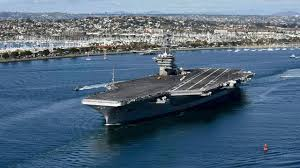
Table of Contents
Introduction:
The United States Navy has long been a symbol of naval dominance and global military power. However, recent reports reveal that US warship production has hit a 25-year low, raising significant concerns about the state of American naval capabilities and the broader implications for national security. As the production of new warships dwindles, the US Navy finds itself lagging behind China, which has rapidly expanded its naval fleet in recent years. This development has prompted a critical examination of the current state of US naval production and its potential impact on global military balance.
Decline in US Navy Warship Production:
The decline in US Navy warship production is a concerning trend that has emerged over the past decade. According to recent data, the number of new warships being built and delivered to the US Navy has reached its lowest level in 25 years. Several factors contribute to this decline, including budget constraints, program delays, and shifting priorities within the defense sector.
Factors Contributing to the Decline:
- Budget Constraints:
One of the primary factors impacting US Navy warship production is budgetary limitations. In recent years, the defense budget has faced increasing pressure from various sectors, leading to constrained funding for naval programs. Budget cuts and fiscal pressures have forced the Navy to prioritize certain programs over others, resulting in fewer new warships being built. - Program Delays and Cost Overruns:
The production of new warships has also been hindered by delays and cost overruns associated with various naval programs. Developmental challenges, technical issues, and procurement problems have plagued several shipbuilding projects, leading to extended timelines and increased costs. These issues have contributed to the overall reduction in the number of new ships entering service. - Shifting Priorities:
The changing geopolitical landscape and evolving defense priorities have influenced the US Navy’s focus. As the Navy adapts to new threats and strategic needs, resources and attention have shifted away from traditional shipbuilding programs. This shift has impacted the rate at which new warships are produced and delivered.
China’s Rapid Naval Expansion:
In stark contrast to the US decline, China has made significant strides in expanding its naval capabilities. The Chinese Navy, known as the People’s Liberation Army Navy (PLAN), has rapidly increased its fleet size and modernized its warships. This expansion has been driven by a combination of aggressive investment in naval technology, strategic priorities, and a focus on regional dominance.
- Fleet Expansion:
China has embarked on an ambitious program to expand its naval fleet, with a focus on increasing the number and capabilities of its warships. The PLAN has launched a range of new vessels, including aircraft carriers, destroyers, frigates, and submarines. This rapid expansion has positioned China as a formidable naval power in the Indo-Pacific region. - Technological Advancements:
China’s naval modernization efforts have been characterized by significant technological advancements. The development of advanced shipbuilding techniques, state-of-the-art weaponry, and cutting-edge systems has enhanced the capabilities of Chinese warships. This technological progress has contributed to the growing strength and reach of the PLAN. - Strategic Objectives:
China’s naval expansion is closely aligned with its strategic objectives in the Indo-Pacific region. The PLAN’s growing presence is intended to assert China’s influence, safeguard its maritime interests, and challenge the dominance of traditional naval powers. This strategic focus has driven the rapid buildup of naval assets.
Implications for US Naval Power:
The decline in US Navy warship production and the growing capabilities of China’s naval fleet have significant implications for global military balance and US naval power.
- Reduced Global Presence:
The decrease in the number of new warships entering service affects the US Navy’s ability to maintain a robust global presence. Fewer warships limit the Navy’s capacity to project power, respond to emerging threats, and participate in international operations. This reduction in global presence could impact the US’s ability to influence global maritime affairs. - Strategic Vulnerability:
A reduced naval fleet may affect the US Navy’s strategic posture, potentially impacting its ability to deter adversaries and protect national interests. As China continues to expand its naval capabilities, there are concerns about potential challenges to US naval dominance and the need for strategic adjustments to address evolving threats. - Military Readiness:
The production decline also raises concerns about the overall readiness of the US Navy. Maintaining a modern and capable fleet requires ongoing investment in new ships and technology. The reduced production rate could affect the Navy’s ability to keep pace with technological advancements and maintain readiness for diverse mission requirements.
Responses and Future Outlook:
In response to the declining warship production and growing naval competition, several measures and strategies are being considered:
- Increased Funding and Investment:
There are calls for increased funding and investment in US naval programs to address the production shortfall. Advocates argue that boosting the defense budget and prioritizing shipbuilding programs are essential for maintaining naval superiority and addressing emerging challenges. - Program Reforms and Efficiency:
Efforts to streamline shipbuilding programs and improve efficiency are underway. Addressing delays, cost overruns, and programmatic issues is crucial for enhancing the production rate and ensuring timely delivery of new warships.
Conclusion:
The recent decline in US Navy warship production, combined with China’s rapid naval expansion, underscores a critical moment in naval history. The decrease in new warships entering service poses challenges for the US Navy’s global presence, strategic posture, and readiness. As the geopolitical landscape evolves, addressing these issues will be crucial for maintaining naval dominance and ensuring that the US Navy can effectively meet its strategic objectives. The ongoing dialogue about funding, program reforms, and strategic adjustments will play a key role in shaping the future of US naval power and its role in global security.
Disclaimer:
This article is based on current data and analysis and may not reflect the most recent developments in naval production or geopolitical dynamics. Readers are encouraged to consult authoritative sources and official statements for the latest updates and comprehensive information.









